Coral Bleaching Detection in the Hawaiian Islands Using Spatio-Temporal Standardized Bottom Reflectance and Planet Dove Satellites
Abstract
1. Introduction
2. Materials and Methods
2.1. Data Collection and Pre-Processing
2.2. Baseline Reflectance Distribution
2.3. Test of Three Temporal Windows for SBR
- (1)
- A weekly window, where the SBR is computed individually for each week i during the bleaching period.r = ri.
- (2)
- A cumulative average, where the SBR is computed from the average bottom reflectance of each week j from the start of the bleaching period until the current week i. For example, if we examine the week of November 25, we get an average of August through November 25.
- (3)
- A three-week moving average of the observation week i, the week prior, and the week after.
2.4. Verification
3. Results
3.1. Overall Detectability of Coral Bleaching Locations
3.2. SBR Sensitivity for Detecting the Bleaching Events
4. Discussion
5. Conclusions
- (1)
- For the goal of detecting the locations in the coral bleaching events, it is critical to set a threshold of how high a bottom reflectance is needed to represent a coral bleaching event. The SBR method we used is based on simple distributional statistics, and provides a feasible approach to obtain a deterministic value for the pixel brightness changes expected in coral bleaching events. The temporal moving window played an important role in reducing the noise and, thus, enhancing the signal-to-noise ratio by taking multiple images in the bleaching period. This essential transformation reduced susceptibility to the time-varying influences on the data and therefore improved the performance for coral bleaching detection.
- (2)
- With the Planet Dove satellite data, the cumulative SBR and three-week average SBR were able to detect the coral bleaching locations identified in the field. The two temporally averaged SBR approaches further reduced the susceptibility to frame-frame variation during the bleaching period. We found that the cumulative approach could detect the highest proportion of coral bleaching locations, while the three-week average SBR performed nearly as well for detecting coral bleaching locations. However, the cumulative approach over-averaged the data, and therefore the sensitivity of the bleaching detection was not as significant as the three-week average approach.
Author Contributions
Funding
Acknowledgments
Conflicts of Interest
Appendix A
| Locations 2 and 4 (Planet Dove quad L15-0130E-1146N) | ||
| Week | Average rb for the Whole Quad | Average rb for Coral Regions Define by the GAO |
| 21 October 2019 to 28 October 2019 | 96.40 | -878.72 |
| 28 October 2019 to 04 November 2019 | 64.02 | -730.02 |
| 04 November 2019 to 11 November 2019 | 434.51 | -146.72 |
| 11 November 2019 to 18 November 2019 | 332.45 | -218.42 |
| 18 November 2019 to 25 November 2019 | 318.34 | -386.23 |
| 25 November 2019 to 02 December 2019 | 161.53 | -626.55 |
| Locations 5 and 10 (Planet Dove quad L15-0132E-1146N) | ||
| Week | Average rb for the Whole Quad | Average rb for Coral Regions Define by the GAO |
| 21 October 2019 to 28 October 2019 | -680.07 | -662.52 |
| 28 October 2019 to 04 November 2019 | -394.89 | -290.99 |
| 04 November 2019 to 11 November 2019 | -895.58 | -1513.47 |
| 11 November 2019 to 18 November 2019 | -314.39 | -392.45 |
| 18 November 2019 to 25 November 2019 | -186.68 | -402.37 |
| 25 November 2019 to 02 December 2019 | 475.52 | 338.59 |
| Locations for 11 (Planet Dove quad L15-0132E-1145N) | ||
| Week | Average rb for the Whole Quad | Average rb for Coral Regions Define by the GAO |
| 21 October 2019 to 28 October 2019 | -456.35 | -281.73 |
| 28 October 2019 to 04 November 2019 | 431.70 | -163.27 |
| 04 November 2019 to 11 November 2019 | -960.76 | -51.54 |
| 11 November 2019 to 18 November 2019 | -632.15 | -290.47 |
| 18 November 2019 to 25 November 2019 | -790.94 | 643.48 |
| 25 November 2019 to 02 December 2019 | -875.62 | 146.68 |
| Locations 18 (Planet Dove quad L15-0116E-1151N) | ||
| Week | Average rb for the Whole Quad | Average rb for Coral Regions Define by the GAO |
| 21 October 2019 to 28 October 2019 | -23.59 | 188.58 |
| 28 October 2019 to 04 November 2019 | 423.79 | 400.24 |
| 04 November 2019 to 11 November 2019 | -383.44 | 1.47 |
| 11 November 2019 to 18 November 2019 | -1300.36 | -1030.24 |
| 18 November 2019 to 25 November 2019 | -1748.58 | -1859.88 |
| 25 November 2019 to 02 December 2019 | -608.75 | -477.89 |
| Location 1 (Planet Dove quad L15-0137E-1141N) | ||
| Week | Average rb for the Whole Quad | Average rb for Coral Regions Define by the GAO |
| 21 October 2019 to 28 October 2019 | -547.49 | -513.25 |
| 28 October 2019 to 04 November 2019 | -298.84 | -201.47 |
| 04 November 2019 to 11 November 2019 | -632.89 | -438.36 |
| 11 November 2019 to 18 November 2019 | -817.84 | -756.81 |
| 18 November 2019 to 25 November 2019 | -542.56 | -511.68 |
| 25 November 2019 to 02 December 2019 | 181.55 | 72.28 |
| Location 3 (Planet Dove quad L15-0137E-1140N) | ||
| Week | Average rb for the Whole Quad | Average rb for Coral Regions Define by the GAO |
| 21 October 2019 to 28 October 2019 | -1158.43 | -534.49 |
| 28 October 2019 to 04 November 2019 | -1197.39 | -528.27 |
| 04 November 2019 to 11 November 2019 | -1725.19 | -877.68 |
| 11 November 2019 to 18 November 2019 | -1754.35 | -895.11 |
| 18 November 2019 to 25 November 2019 | -1078.23 | -478.80 |
| 25 November 2019 to 02 December 2019 | -20.77 | 284.14 |
| Location 16 and 17 (Planet Dove quad L15-0126E-1149N) | ||
| Week | Average rb for the Whole Quad | Average rb for Coral Regions Define by the GAO |
| 21 October 2019 to 28 October 2019 | 172.05 | -342.25 |
| 28 October 2019 to 04 November 2019 | 274.19 | -95.60 |
| 04 November 2019 to 11 November 2019 | -133.69 | -610.10 |
| 11 November 2019 to 18 November 2019 | 189.42 | -453.87 |
| 18 November 2019 to 25 November 2019 | 806.59 | 312.72 |
| 25 November 2019 to 02 December 2019 | 550.11 | 12.15 |
| Locations 8 (Planet Dove quad L15-0131E-1145N) | ||
| Week | Average rb for the Whole Quad | Average rb for Coral Regions Define by the GAO |
| 21 October 2019 to 28 October 2019 | -506.56 | -477.14 |
| 28 October 2019 to 04 November 2019 | -173.06 | -87.74 |
| 04 November 2019 to 11 November 2019 | -286.13 | -258.22 |
| 11 November 2019 to 18 November 2019 | -192.93 | -144.63 |
| 18 November 2019 to 25 November 2019 | 367.06 | 501.89 |
| 25 November 2019 to 02 December 2019 | 127.52 | 110.54 |
| Locations 13 (Planet Dove quad L15-0131E-1146N) | ||
| Week | Average rb for the Whole Quad | Average rb for Coral Regions Define by the GAO |
| 21 October 2019 to 28 October 2019 | 219.53 | 57.16 |
| 28 October 2019 to 04 November 2019 | 422.59 | 110.45 |
| 04 November 2019 to 11 November 2019 | 578.90 | 449.79 |
| 11 November 2019 to 18 November 2019 | 466.32 | 308.84 |
| 18 November 2019 to 25 November 2019 | 662.05 | 432.10 |
| 25 November 2019 to 02 December 2019 | 1039.51 | 720.43 |
| Location 6 (Planet Dove quad L15-0136E-1139N) | ||
| Week | Average rb for the Whole Quad | Average rb for Coral Regions Define by the GAO |
| 21 October 2019 to 28 October 2019 | -895.76 | -224.52 |
| 28 October 2019 to 04 November 2019 | -931.16 | -104.35 |
| 04 November 2019 to 11 November 2019 | -472.10 | 237.34 |
| 11 November 2019 to 18 November 2019 | -522.85 | 157.46 |
| 18 November 2019 to 25 November 2019 | -422.14 | 195.03 |
| 25 November 2019 to 02 December 2019 | -426.70 | 189.22 |
References
- Bellwood, D.R.; Hughes, T.P.; Folke, C.; Nyström, M. Confronting the coral reef crisis. Nature 2004, 429, 827–833. [Google Scholar] [CrossRef]
- Moberg, F.; Folke, C. Ecological goods and services of coral reef ecosystems. Ecol. Econ. 1999, 29, 215–233. [Google Scholar] [CrossRef]
- Hoegh-Guldberg, O. Likely ecological impacts of global warming and climate change on the Great Barrier Reef by 2050 and beyond. Qld. Land Resour. Trib. Rep. Brisb. Aust. 2007. [Google Scholar]
- Lesser, M.P. Coral Bleaching: Causes and Mechanisms. In Coral Reefs: An Ecosystem in Transition; Springer: Dordrecht, The Netherlands, 2011; pp. 405–419. [Google Scholar]
- Donner, S.D.; Skirving, W.J.; Little, C.M.; Oppenheimer, M.; Hoegh-Guldberg, O. Global assessment of coral bleaching and required rates of adaptation under climate change. Glob. Chang. Biol. 2005, 11, 2251–2265. [Google Scholar] [CrossRef]
- Barange, M.; Merino, G.; Blanchard, J.; Scholtens, J.; Harle, J.; Allison, E.; Allen, J.; Holt, J.; Jennings, S. Impacts of climate change on marine ecosystem production in societies dependent on fisheries. Nat. Clim. Chang. 2014, 4, 211–216. [Google Scholar] [CrossRef]
- Griffiths, J.R.; Kadin, M.; Nascimento, F.J.; Tamelander, T.; Törnroos, A.; Bonaglia, S.; Bonsdorff, E.; Brüchert, V.; Gårdmark, A.; Järnström, M. The importance of benthic–pelagic coupling for marine ecosystem functioning in a changing world. Glob. Chang. Biol. 2017, 23, 2179–2196. [Google Scholar] [CrossRef]
- Kwiatkowski, L.; Cox, P.; Halloran, P.R.; Mumby, P.J.; Wiltshire, A.J. Coral bleaching under unconventional scenarios of climate warming and ocean acidification. Nat. Clim. Chang. 2015, 5, 777–781. [Google Scholar] [CrossRef]
- Hoegh-Guldberg, O. Climate change, coral bleaching and the future of the world’s coral reefs. Mar. Freshw. Res. 1999, 50, 839–866. [Google Scholar] [CrossRef]
- Earle, S.A. Sea Change: A Message of the Oceans; Ballantine Books: New York, NY, USA, 1996. [Google Scholar]
- Brown, B.E. Coral bleaching: Causes and consequences. Coral Reefs 1997, 16, S129–S138. [Google Scholar] [CrossRef]
- Burke, L.M.; Reytar, K.; Spalding, M.; Perry, A. Reefs at Risk Revisited; World Resources Institute: Washington, DC, USA, 2017. [Google Scholar]
- Maglione, P.; Parente, C.; Vallario, A. Coastline extraction using high resolution WorldView-2 satellite imagery. Eur. J. Remote Sens. 2014, 47, 685–699. [Google Scholar] [CrossRef]
- Specht, M.; Specht, C.; Lewicka, O.; Makar, A.; Burdziakowski, P.; Dąbrowski, P. Study on the Coastline Evolution in Sopot (2008–2018) Based on Landsat Satellite Imagery. J. Mar. Sci. Eng. 2020, 8, 464. [Google Scholar] [CrossRef]
- Wang, X.; Liu, Y.; Ling, F.; Liu, Y.; Fang, F. Spatio-Temporal Change Detection of Ningbo Coastline Using Landsat Time-Series Images during 1976–2015. ISPRS Int. J. Geo Inf. 2017, 6, 68. [Google Scholar] [CrossRef]
- Torres-Pérez, J.L.; Guild, L.S.; Armstrong, R.A. Hyperspectral Distinction of Two Caribbean Shallow-Water Corals Based on Their Pigments and Corresponding Reflectance. Remote Sens. 2012, 4, 3813–3832. [Google Scholar] [CrossRef]
- Chauvaud, S.; Bouchon, C.; Maniere, R. Remote sensing techniques adapted to high resolution mapping of tropical coastal marine ecosystems (coral reefs, seagrass beds and mangrove). Int. J. Remote Sens. 1998, 19, 3625–3639. [Google Scholar] [CrossRef]
- Thompson, D.R.; Hochberg, E.J.; Asner, G.P.; Green, R.O.; Knapp, D.E.; Gao, B.-C.; Garcia, R.; Gierach, M.; Lee, Z.; Maritorena, S.; et al. Airborne mapping of benthic reflectance spectra with Bayesian linear mixtures. Remote Sens. Environ. 2017, 200, 18–30. [Google Scholar] [CrossRef]
- Asner, G.P.; Martin, R.E.; Mascaro, J. Coral reef atoll assessment in the South China Sea using Planet Dove satellites. Remote Sens. Ecol. Conserv. 2017, 3, 57–65. [Google Scholar] [CrossRef]
- Foo, S.A.; Asner, G.P. Scaling Up Coral Reef Restoration Using Remote Sensing Technology. Front. Mar. Sci. 2019, 6. [Google Scholar] [CrossRef]
- Allen Coral Atlas. Available online: https://allencoralatlas.org/ (accessed on 1 May 2020).
- Solano-Correa, Y.T.; Bovolo, F.; Bruzzone, L. An Approach for Unsupervised Change Detection in Multitemporal VHR Images Acquired by Different Multispectral Sensors. Remote Sens. 2018, 10, 533. [Google Scholar] [CrossRef]
- Lv, Z.; Liu, T.; Wan, Y.; Benediktsson, J.A.; Zhang, X. Post-Processing Approach for Refining Raw Land Cover Change Detection of Very High-Resolution Remote Sensing Images. Remote Sens. 2018, 10, 472. [Google Scholar] [CrossRef]
- Wang, X.; Liu, S.; Du, P.; Liang, H.; Xia, J.; Li, Y. Object-Based Change Detection in Urban Areas from High Spatial Resolution Images Based on Multiple Features and Ensemble Learning. Remote Sens. 2018, 10, 276. [Google Scholar] [CrossRef]
- Lyons, M.B.; Roelfsema, C.M.; Phinn, S.R. Towards understanding temporal and spatial dynamics of seagrass landscapes using time-series remote sensing. Estuar. Coast. Shelf Sci. 2013, 120, 42–53. [Google Scholar] [CrossRef]
- Palandro, D.A.; Andréfouët, S.; Hu, C.; Hallock, P.; Müller-Karger, F.E.; Dustan, P.; Callahan, M.K.; Kranenburg, C.; Beaver, C.R. Quantification of two decades of shallow-water coral reef habitat decline in the Florida Keys National Marine Sanctuary using Landsat data (1984–2002). Remote Sens. Environ. 2008, 112, 3388–3399. [Google Scholar] [CrossRef]
- Hunter, P.D.; Tyler, A.N.; Willby, N.J.; Gilvear, D.J. The spatial dynamics of vertical migration by Microcystis aeruginosa in a eutrophic shallow lake: A case study using high spatial resolution time-series airborne remote sensing. Limnol. Oceanogr. 2008, 53, 2391–2406. [Google Scholar] [CrossRef]
- Chen, L.; Jin, Z.; Michishita, R.; Cai, J.; Yue, T.; Chen, B.; Xu, B. Dynamic monitoring of wetland cover changes using time-series remote sensing imagery. Ecol. Inform. 2014, 24, 17–26. [Google Scholar] [CrossRef]
- Evangelista, P.H.; Stohlgren, T.J.; Morisette, J.T.; Kumar, S. Mapping Invasive Tamarisk (Tamarix): A Comparison of Single-Scene and Time-Series Analyses of Remotely Sensed Data. Remote Sens. 2009, 1, 519–533. [Google Scholar] [CrossRef]
- Li, J.; Knapp, D.E.; Schill, S.R.; Roelfsema, C.; Phinn, S.; Silman, M.; Mascaro, J.; Asner, G.P. Adaptive bathymetry estimation for shallow coastal waters using Planet Dove satellites. Remote Sens. Environ. 2019, 232, 111302. [Google Scholar] [CrossRef]
- Xu, Y.; Wang, L.; Ross, K.W.; Liu, C.; Berry, K. Standardized Soil Moisture Index for Drought Monitoring Based on Soil Moisture Active Passive Observations and 36 Years of North American Land Data Assimilation System Data: A Case Study in the Southeast United States. Remote Sens. 2018, 10, 301. [Google Scholar] [CrossRef]
- Asner, G.P.; Vaughn, N.R.; Heckler, J.; Knapp, D.E.; Balzotti, C.; Shafron, E.; Martin, R.E.; Neilson, B.J.; Gove, J.M. Large-scale spectroscopic mapping of live corals to guide reef conservation. Proc. Natl. Acad. Sci. submitted.
- NOAA Coral Reef Watch. NOAA Coral Reef Watch Version 3.1 Daily Global 5-km Satellite Coral Bleaching Degree Heating Week Product, 3 June 2013–2 June 2014. 2018, Updated Daily. Available online: https://coralreefwatch.noaa.gov/satellite/hdf/index.php (accessed on 31 December 2019).
- Planet Team. Planet Application Program Interface: In Space for Life on Earth, Planet Labs: San Fransisco, CA, USA, 2017; 40.
- Asner, G.P.; Knapp, D.E.; Boardman, J.; Green, R.O.; Kennedy-Bowdoin, T.; Eastwood, M.; Martin, R.E.; Anderson, C.; Field, C.B. Carnegie Airborne Observatory-2: Increasing science data dimensionality via high-fidelity multi-sensor fusion. Remote Sens. Environ. 2012, 124, 454–465. [Google Scholar] [CrossRef]
- Allen Coral Atlas Planet Satellite Imagery. Available online: https://allencoralatlas.org/methods/ (accessed on 1 May 2020).
- Kotchenova, S.Y.; Vermote, E.F.; Matarrese, R.; Klemm, J.F.J. Validation of a vector version of the 6S radiative transfer code for atmospheric correction of satellite data. Part I: Path radiance. Appl. Opt. 2006, 45, 6762–6774. [Google Scholar] [CrossRef]
- Kotchenova, S.Y.; Vermote, E.F. Validation of a vector version of the 6S radiative transfer code for atmospheric correction of satellite data. Part II. Homogeneous Lambertian and anisotropic surfaces. Appl. Opt. 2007, 46, 4455–4464. [Google Scholar] [CrossRef] [PubMed]
- Li, J.; Fabina, N.S.; Knapp, D.E.; Asner, G.P. The Sensitivity of Multi-spectral Satellite Sensors to Benthic Habitat Change. Remote Sens. 2020, 12, 532. [Google Scholar] [CrossRef]
- Qi, L.; Lee, Z.; Hu, C.; Wang, M. Requirement of minimal signal-to-noise ratios of ocean color sensors and uncertainties of ocean color products. J. Geophys. Res. Ocean. 2017, 122, 2595–2611. [Google Scholar] [CrossRef]
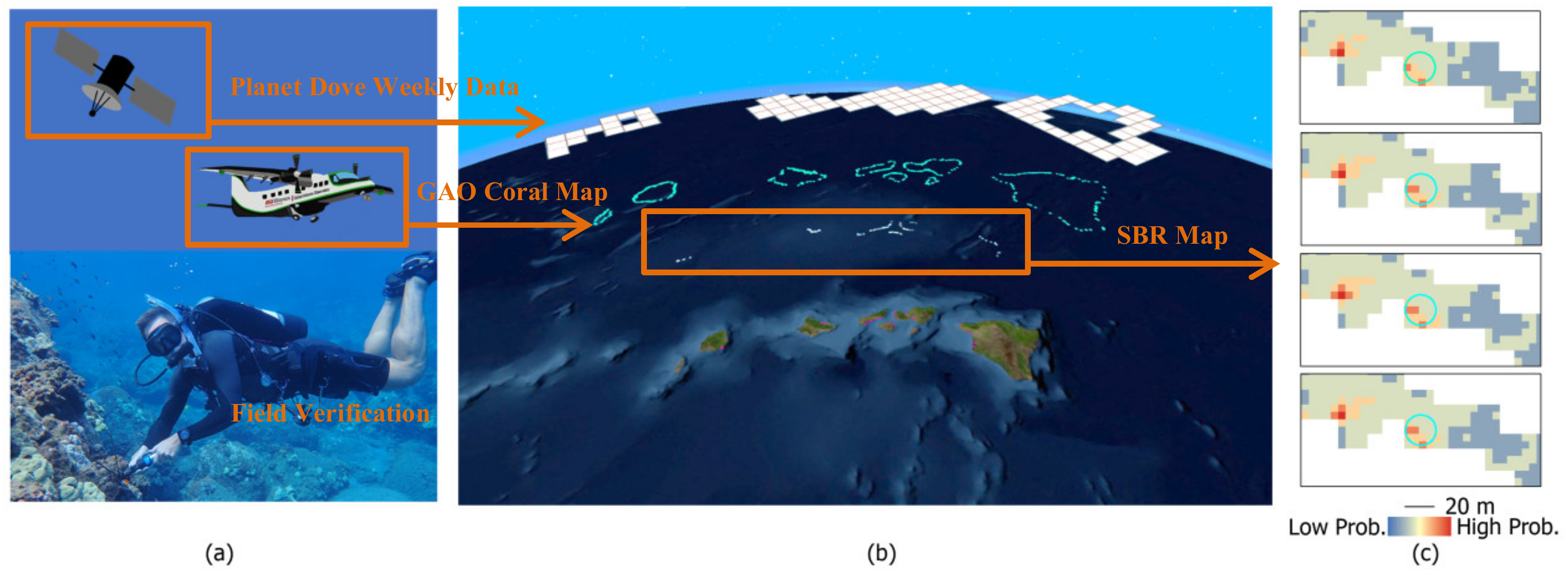

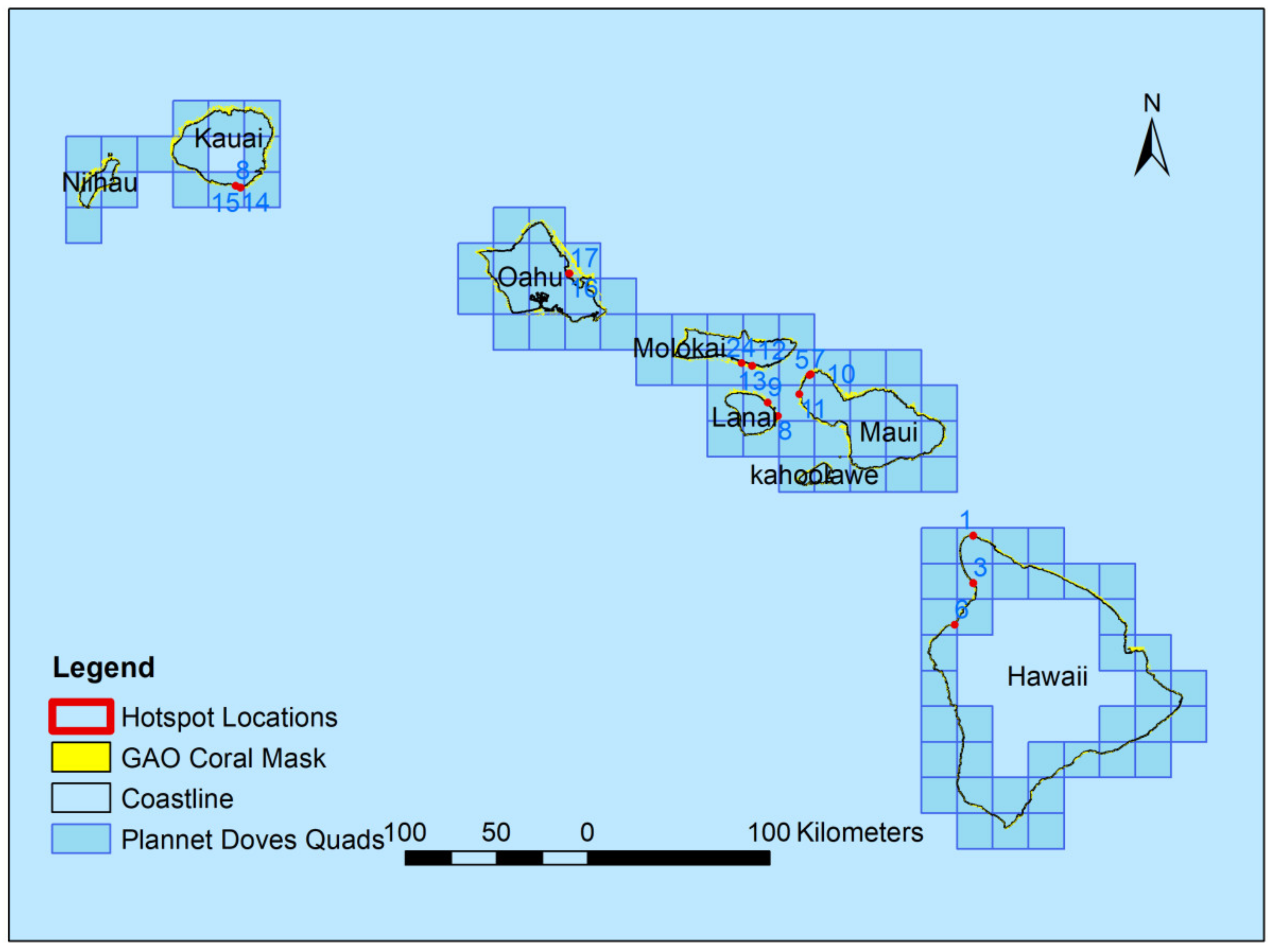
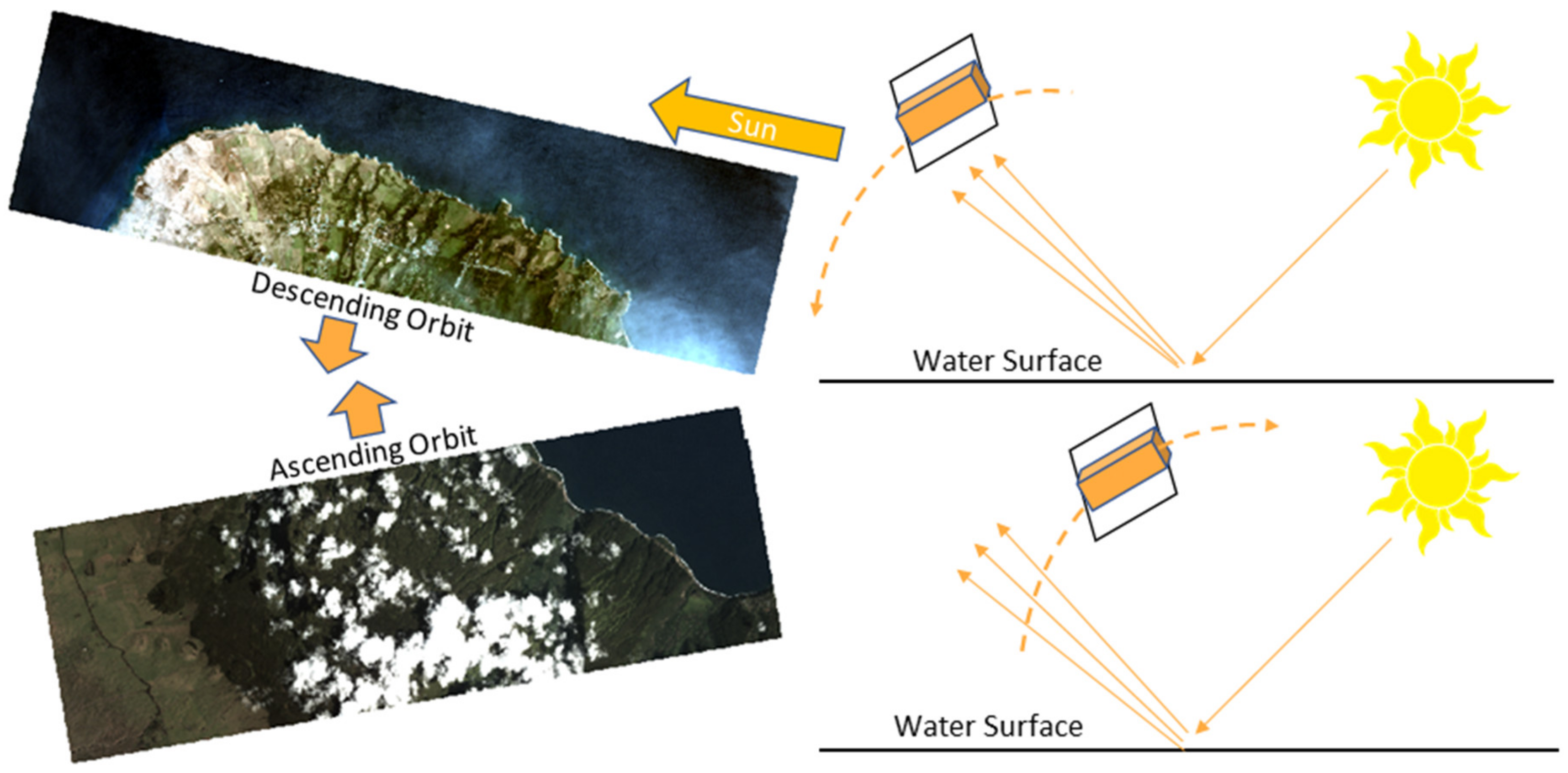
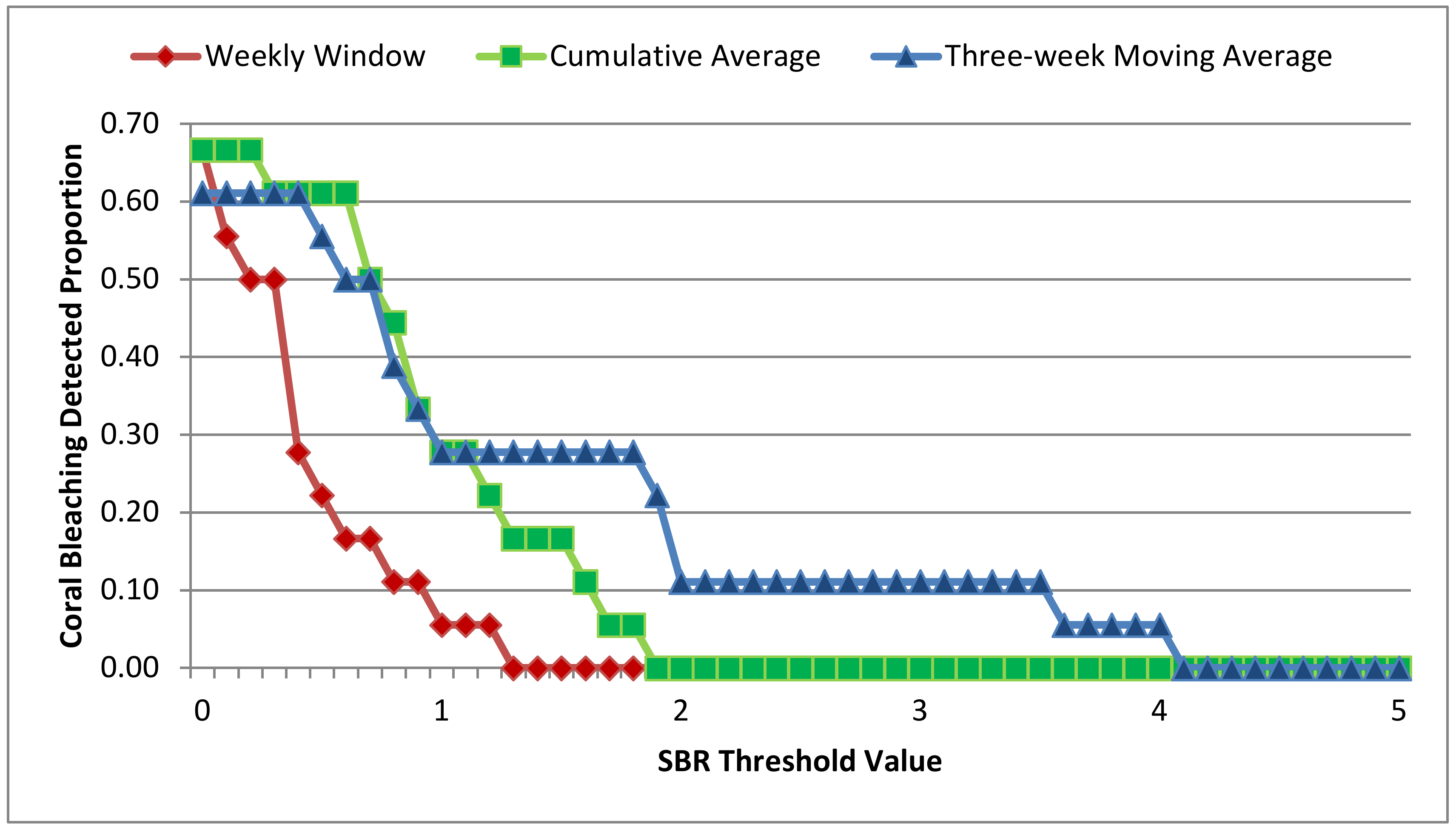
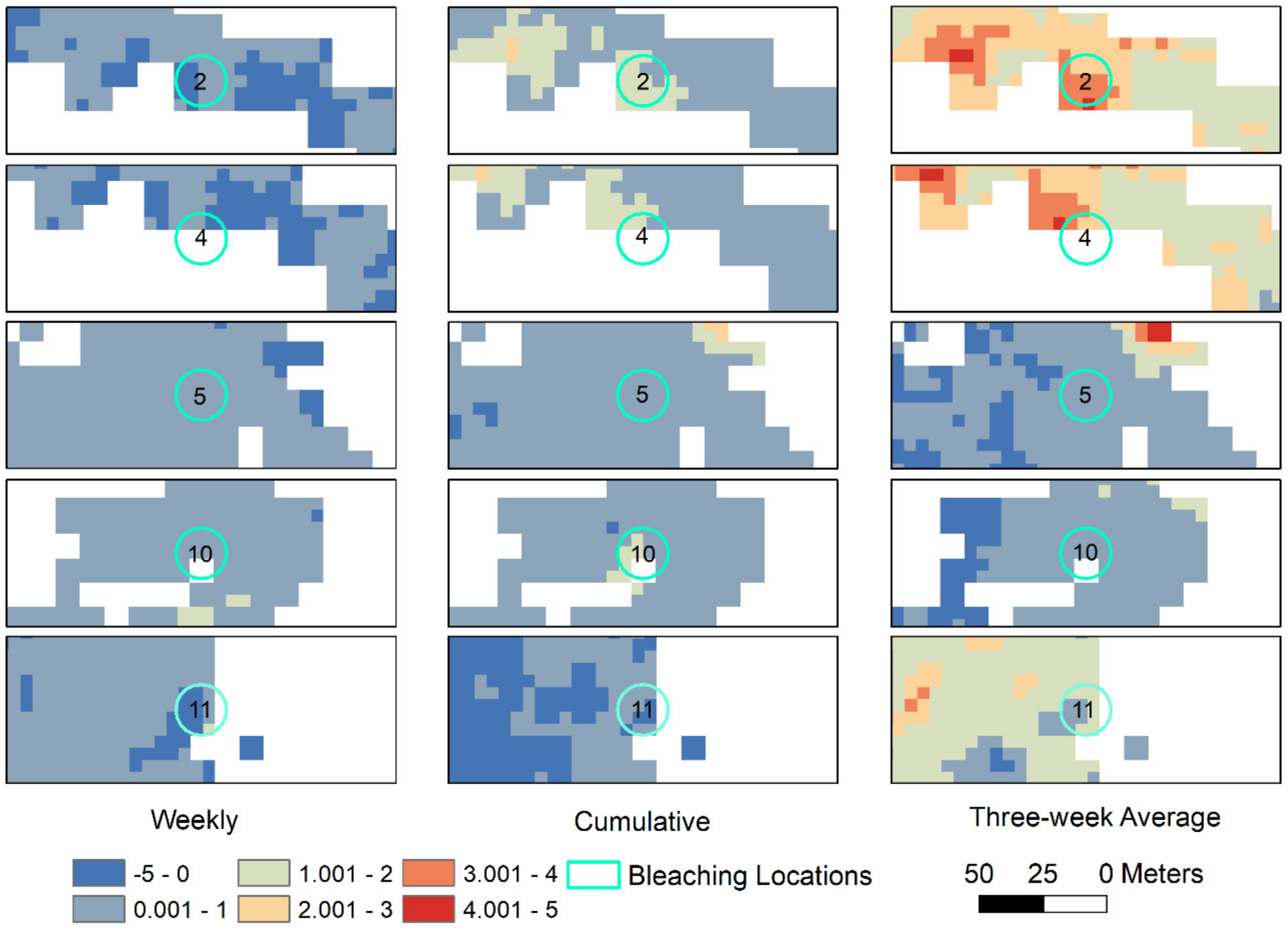
| Bleaching Location ID | Date | Island | Bleached Percent of Coral (%) |
|---|---|---|---|
| 1 | 9 November 2019 | Hawaii | 79 |
| 2 | 16 November 2019 | Molokai | 64 |
| 3 | 9 November 2019 | Hawaii | 56 |
| 4 | 16 November 2019 | Molokai | 39 |
| 5 | 13 November 2019 | Maui | 39 |
| 6 | 29 October 2019 | Hawaii | 37 |
| 7 | 13 November 2019 | Maui | 33 |
| 8 | 14 November 2019 | Lanai | 30 |
| 9 | 14 November 2019 | Lanai | 30 |
| 10 | 13 November 2019 | Maui | 29 |
| 11 | 13 November 2019 | Maui | 23 |
| 12 | 16 November 2019 | Molokai | 22 |
| 13 | 16 November 2019 | Molokai | 16 |
| 14 | 15 November 2019 | Kauai | 15 |
| 15 | 15 November 2019 | Kauai | 13 |
| 16 | 15 November 2019 | Oahu | 12 |
| 17 | 15 November 2019 | Oahu | 11 |
| 18 | 15 November 2019 | Kauai | 8 |
| Bleaching Location ID | Date | Weekly Window | Cumulative Average | Three-Week Moving Average |
|---|---|---|---|---|
| 1 | 9 November 2019 | -0.4728 | 1.2073 | -0.674 |
| 2 | 16 November 2019 | 0.4003 | 1.8673 | 4.0749 |
| 3 | 9 November 2019 | -1.0929 | 0.9955 | -1.2163 |
| 4 | 16 November 2019 | 0.396 | 1.5337 | 3.5447 |
| 5 | 13 November 2019 | 0.5796 | 0.6341 | 0.711 |
| 6 | 29 October 2019 | -0.5184 | 0.8016 | 1.8702 |
| 7 | 13 November 2019 | 0.3796 | 1.146 | 0.4246 |
| 8 | 14 November 2019 | 0.3667 | -0.4089 | 1.9066 |
| 9 | 14 November 2019 | 0.9061 | -0.778 | 0.9881 |
| 10 | 13 November 2019 | 0.7084 | 1.6423 | 0.8612 |
| 11 | 13 November 2019 | 1.2185 | 0.2236 | 1.9949 |
| 12 | 16 November 2019 | 0.1767 | -0.0548 | 0.776 |
| 13 | 16 November 2019 | -0.0044 | -0.071 | 0.5855 |
| 14 | 15 November 2019 | -0.0839 | -0.6213 | -1.1263 |
| 15 | 15 November 2019 | 0.0721 | -0.54 | -1.1583 |
| 16 | 15 November 2019 | 0.3224 | 0.7325 | -0.1811 |
| 17 | 15 November 2019 | 0.0947 | 0.899 | -0.0779 |
| 18 | 15 November 2019 | data missing | 0.6689 | -0.2641 |
| Proportion of Detectable Locations to the 18 Locations | 4/17 | 11/18 | 10/18 |
© 2020 by the authors. Licensee MDPI, Basel, Switzerland. This article is an open access article distributed under the terms and conditions of the Creative Commons Attribution (CC BY) license (http://creativecommons.org/licenses/by/4.0/).
Share and Cite
Xu, Y.; Vaughn, N.R.; Knapp, D.E.; Martin, R.E.; Balzotti, C.; Li, J.; Foo, S.A.; Asner, G.P. Coral Bleaching Detection in the Hawaiian Islands Using Spatio-Temporal Standardized Bottom Reflectance and Planet Dove Satellites. Remote Sens. 2020, 12, 3219. https://doi.org/10.3390/rs12193219
Xu Y, Vaughn NR, Knapp DE, Martin RE, Balzotti C, Li J, Foo SA, Asner GP. Coral Bleaching Detection in the Hawaiian Islands Using Spatio-Temporal Standardized Bottom Reflectance and Planet Dove Satellites. Remote Sensing. 2020; 12(19):3219. https://doi.org/10.3390/rs12193219
Chicago/Turabian StyleXu, Yaping, Nicholas R. Vaughn, David E. Knapp, Roberta E. Martin, Christopher Balzotti, Jiwei Li, Shawna A. Foo, and Gregory P. Asner. 2020. "Coral Bleaching Detection in the Hawaiian Islands Using Spatio-Temporal Standardized Bottom Reflectance and Planet Dove Satellites" Remote Sensing 12, no. 19: 3219. https://doi.org/10.3390/rs12193219
APA StyleXu, Y., Vaughn, N. R., Knapp, D. E., Martin, R. E., Balzotti, C., Li, J., Foo, S. A., & Asner, G. P. (2020). Coral Bleaching Detection in the Hawaiian Islands Using Spatio-Temporal Standardized Bottom Reflectance and Planet Dove Satellites. Remote Sensing, 12(19), 3219. https://doi.org/10.3390/rs12193219







